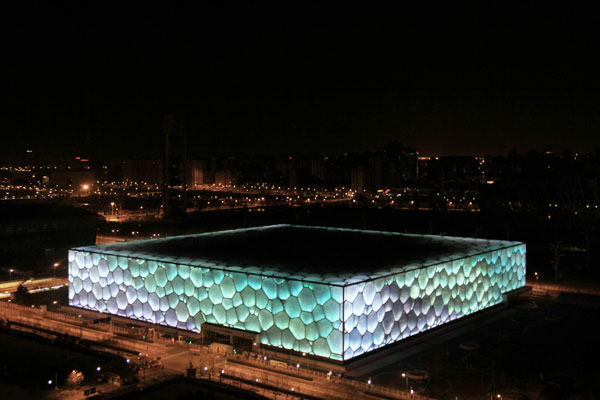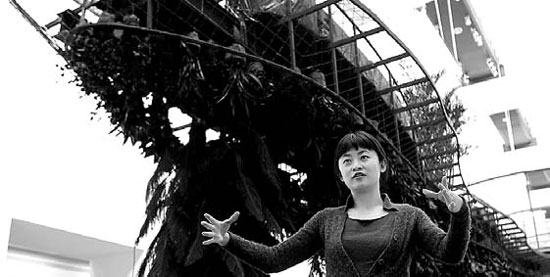Ink meets light
Updated: 2013-01-18 07:44
By Chen Nan (China Daily)
|
||||||||

Artist Ma Wen returns to Beijing's Olympic venue with new designs for the Water Cube, and a new outlook on traditional Chinese painting, Chen Nan reports.
Ma Wen caught a bad cold recently. For the past 30 days, she had been walking outside for hours after midnight in Beijing.
The 39-year-old visual artist was one of seven members on the core creative team for the opening and closing ceremonies of the Beijing Olympics and Paralympics. Now she is designing new outdoor illuminations for the Water Cube, the National Aquatic Center.
From 1 to 4 am, she and her team tested and adjusted her fluid light show, which will change every day.
"I see bubbles on the Water Cube as human cells. In the daytime they absorb the power from outside and inside the human body, and at night they release emotions through colors," says Ma, who has spent the past six months designing the new work, which will be officially seen by the public in March.
She used a computer program to interpret ancient Chinese teachings such as the I Ching, Tao Te Ching and the traditional Chinese almanac, as well as daily weather and societal conditions. Each day's unique characters and aura are projected as light, color, rhythm and movements on the Water Cube's facade.
She hopes the images will connect with people who are passing by, rather than simply being just decorations.
In her designs, she left the roof of the Water Cube black, unlit.
"When I worked after midnight in Beijing, I saw a different city, a quiet, dreamy and real city," she says.
"I want to retain the top of the architecture's natural outlook, which merges with the darkness at night."
The blackness also flows with the artist's philosophy about mo, or traditional Chinese ink, which she started to apply in her artworks after the Olympic Games.
Renowned choreographer Shen Wei created dance with the free flow of the Chinese ink painting at the Beijing Olympics Opening Ceremony. The combination of the ancient ink painting and the advanced LED technology impressed Ma, who spent eight months working on the visual effects for the opening ceremony.
"Since I grew up in the US, I didn't have the same passion for ink as many other Chinese artists, who grew up being exposed to traditional Chinese painting," Ma says.
She has developed a different perspective on the legacy of ink, which dominates the artistic vocabulary in her series of artworks.
In 2010's Furious Bloom, she composed pots of inked chrysanthemums - the flowers traditionally used in China for funerals - against a white wall, dedicated to a friend's husband who passed away six months after their wedding.
Her attitude toward life and death is also evident in another work - at the foot of Switzerland's Engadine mountain, which overlooks St. Moritz Lake, a 1,000-square-meter area of soil painted black with ink.
Over a few days, a fine layer of tender green grass broke through the black soil to spell the words "Amor Fati", Latin for "embrace your fate" used by the philosopher Freidrich Nietzsche.
"I am so touched by the scene of the fresh green shoots, the evidence of the perseverance and resilience of life," she says. "The ink is organic and made of natural ingredients. Though it smells, I love it."
In the spring of 2011, Ma had her first large exhibition, Hanging Garden in Ink, in the Beijing 798 Art Zone's Ullens Center for Contemporary Art.
The 20-meter-long, 3-meter-wide and 8-meter-high masterpiece is a tableau of 1,400 live plants painted in black Chinese ink, leaving only their flowers in vibrant colors. The lower half of the tableau consists of real plants that mirror the top half of the installation, creating the effect of a garden's reflection on water.
She also used ink and Chinese painting as the primary medium and driving concept in her ongoing collaboration with the New York-based fashion design team Eko-Lab.
In her first major monograph, Jennifer Wen Ma, which was released in Beijing on Jan 5 with traditional Chinese ink as the theme, the book gives a thorough overview of her accomplishments across media as varied as installation, video, drawing, fashion design and performance art.
Curator and writer David Elliott says: "A driving flux and energy characterizes her work rather than any single medium, approach."
The 63-year-old expert, former director of the Museum of Modern Art (Oxford) also says the creativity of many artists has been rooted in the trauma of upheaval and diasporas and Ma's personal history is consonant with this.
In 1986, Ma moved to Oklahoma City in the US with her mother. She says she first thought of becoming an artist when she took an oil-painting class at the age of 16.
"I had the feeling that this was what I was searching for and I had finally found my refuge," she recalls.
She moved to New York and received her master's degree in fine art in 1999 from Pratt Institute, where she was introduced to Cai Guoqiang, a well-known contemporary artist from Fujian province who moved to New York from Japan in 1995.
From 26 to 34 years old, Ma worked as studio director for Cai.
At first, she had no clear vision of how her own art would develop. Cai was and remains a significant figure for her as "friend and mentor", yet she admits that working with him has both "hindered and stimulated development", adding that "under a big tree you have to move away from its shadow to flourish".
While her friends have linked Ma's Chinese ink-based works with Cai's gunpowder-based works, Ma laughs, saying the influence is unconscious.
"He has been experimenting with gunpowder for 20 years and I have just tested Chinese ink for a few years," she says.
Contact the writer at chennan@chinadaily.com.cn.
|
Visual artist Ma Wen has spent the past six months designing the new outdoor illuminations for the Water Cube, the National Aquatic Center, which will officially open to the public in March. Zou Hong / China Daily |
(China Daily 01/18/2013 page20)

 'Taken 2' grabs movie box office crown
'Taken 2' grabs movie box office crown
 Rihanna's 'Diamonds' tops UK pop chart
Rihanna's 'Diamonds' tops UK pop chart
 Fans get look at vintage Rolling Stones
Fans get look at vintage Rolling Stones
 Celebrities attend Power of Women event
Celebrities attend Power of Women event
 Ang Lee breaks 'every rule' to make unlikely new Life of Pi film
Ang Lee breaks 'every rule' to make unlikely new Life of Pi film
 Rihanna almost thrown out of nightclub
Rihanna almost thrown out of nightclub
 'Dark Knight' wins weekend box office
'Dark Knight' wins weekend box office
 'Total Recall' stars gather in Beverly Hills
'Total Recall' stars gather in Beverly Hills
Most Viewed
Editor's Picks

|

|

|

|

|

|
Today's Top News
Boston bombing suspect reported cornered on boat
7.0-magnitude quake hits Sichuan
Cross-talk artist helps to spread the word
'Green' awareness levels drop in Beijing
Palace Museum spruces up
First couple on Time's list of most influential
H7N9 flu transmission studied
Trading channels 'need to broaden'
US Weekly

|

|









